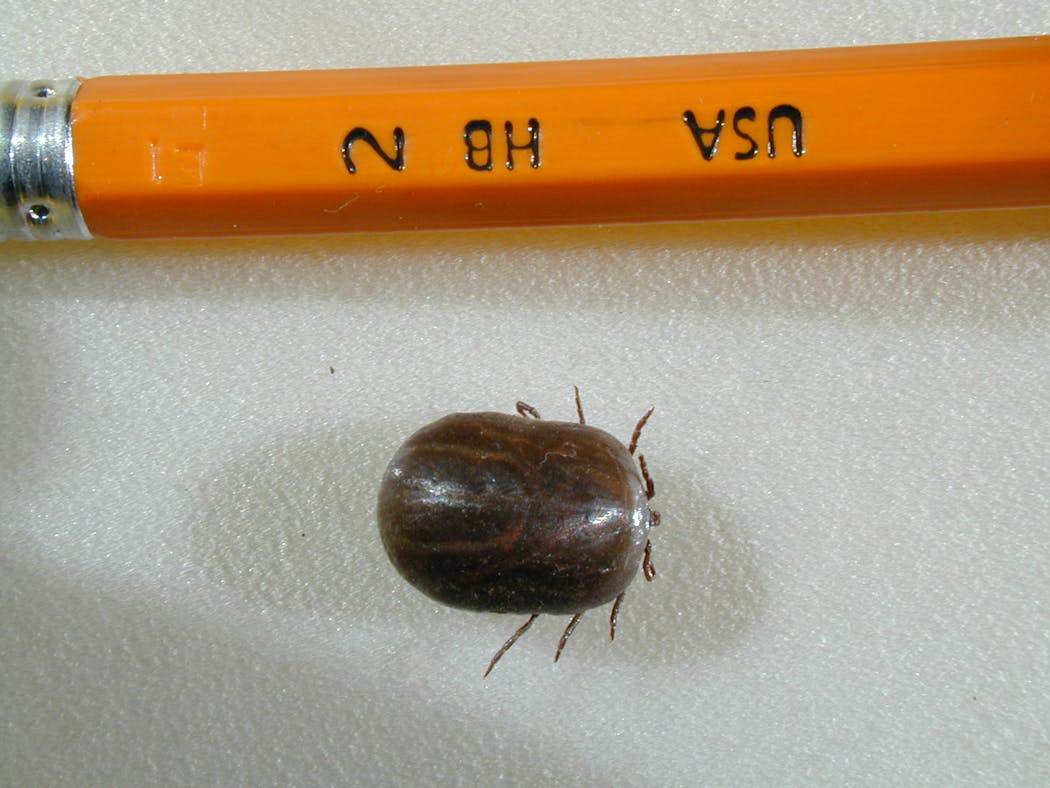A type of tick is draining so much blood from Minnesota's moose that the animals are starving to death. Winter tick populations have exploded along the North Shore as the state's winters and springs have gotten warmer, allowing the parasites to swarm individual moose by the tens of thousands, scientists say.
Some infected moose can't find enough food to replace all the iron, nutrients, heat and blood they lose when the majority of their skin is covered with the engorged, quarter-sized pests.
Minnesota has always been the southern edge of moose range. But the ticks show how hostile the state's habitat has become to the beloved creatures, whose populations seem to be retreating to Canada.
"This is the compounded impact of climate change," said Seth Moore, director of biology and environment for the Grand Portage Band of Chippewa. "You get a series of warmer winters that allow tick populations to explode. Then you get a polar vortex and this occasional very cold weather that can be very hard on moose even without parasites. You end up with a much higher level of mortality than you'd get in any normal year."
Around 30% of moose in Minnesota and in the Grand Portage area died over the past year, with the tick infestation being a major cause, Moore said. Nearly a third of the moose on Lake Superior's Isle Royale also died over that time, the majority from starvation after years of overgrazing on the island, but the tick infestation was also a factor, researchers said.
Minnesota's moose population has been cut in half since 2009, dropping from about 8,000 to somewhere between 3,000 and 4,000. A slew of issues have contributed to that decline, including maturing forests with less food, habitat loss to development, and wolves and bears eating young calves. The Minnesota Department of Natural Resources found in a years-long study that the No. 1 cause of the moose decline was actually white-tailed deer. The deer, which are spreading north into moose territory because of milder winters, carry a brain-worm parasite that is fatal in moose.
Increasing winter tick populations only exacerbate the other threats, Moore said.
The tick problem starts in the spring.
Winter ticks fall off their host around April to lay eggs in the soil. If there is still snow on the ground when they drop, the vast majority of those ticks will drown. Their eggs won't hatch and only a small number will survive to bother moose over the coming year. But if the snow is gone by April and the ground is dry, as it increasingly has been, the ticks will flourish, Moore said.
They hatch and climb to the top of a blade of grass and wait for an animal to pass by. When a moose does, the tiny newborn ticks link up together by the thousands and bury themselves into the great animal's skin, where they remain and feast all summer, fall and winter.
Moose try like crazy to get rid of them, said Sarah Hoy, co-leader of the Isle Royale wolf-moose study and a researcher with Michigan Technical University.
"They scratch and rub on trees, they lick themselves," she said.
Some scratch and lick away so much fur that they're nearly bald. That can be deadly when temperatures drop and bare-skinned moose can freeze to death, Hoy said.
"In bad years we've seen almost naked moose — ghost moose," she said.
Infected female moose may not have the energy to give birth — or their calves may be too anemic to survive, Hoy said.
Adult moose can become lethargic and more prone to predators or susceptible to disease.
As their name suggests, winter ticks become the most problematic around February. That's when they fully engorge and fatten up to the size of a quarter. It's also when there is very little food around for a moose to replace all the energy it loses from the bleeding, Hoy said.
"They're mostly only eating twigs and conifers then that aren't very nutritious even without parasites," she said.
There are no simple ways to reverse winter tick infestations. The parasites are native to North America. But Minnesota still produces enough snowy springs to offer hope, biologists said.
The spring of 2023 was actually pretty close to ideal — with a late snowpack hanging around deep into April. Most of the ticks that fell off moose this spring likely perished, and their populations could remain low for another year or two, Moore said.
In the meantime, the state needs to use every tool it can to protect moose from other threats, he said.
The Grand Portage Band switched its annual bear hunt to the spring, right when moose calves are at their most vulnerable. By having bear bait in the forest at that time, the predators have almost entirely stopped finding and eating moose calves in the reservation, Moore said.
Moore has called on lawmakers and the DNR for years to increase deer harvest limits in core moose range to keep white-tail populations lower and limit the spread of brain-worm.
This summer the state received a $400,000 federal grant to start planning large-scale projects across the North Shore to restore and protect moose habitat. The tricky thing will be finding a way to mimic wildfires and storms — to bring back young forest — without just creating more havens for deer, said Michelle Carstensen, DNR wildlife health program supervisor.
Both deer and moose feast on the vegetation of young early-succession forests.
"Chainsaws must sound like a dinner bell to white-tail deer," she said. "They like a fresh-cut forest right away. Moose wait a couple years."
Small-scale clearings and prescribed burns — those up to about 40 acres — seem to help deer more than moose.
"So we're trying to figure out what we can do on a larger scale," Carstensen said.
Plans for moose habitat will be made over the coming year.
Carolyn Parnell, 'trailblazer' who served as Minnesota's first IT commissioner, dies




